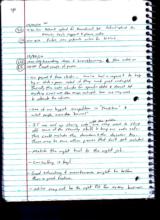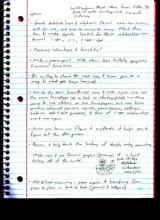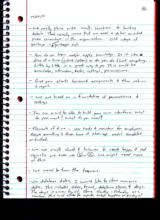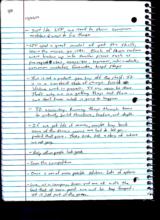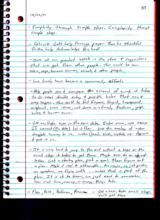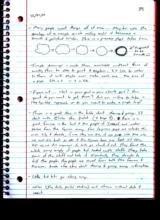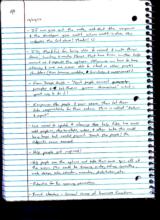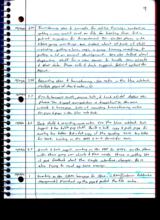|
Basic Assignments
|
Options & Settings
|
Main Time Information
|
||||||||||||||||||||||
|
|
|
|
|
||||||||||||
|
Photo/Image Count: 12
|
||||||||||||
|
|
||||||||||||
|
|
|
Notes:
|
|
-On payroll and time clocks – we’ve had a request to help log or clock a person in/out if they work past midnight. Basically the code checks for specific dates and doesn’t let anything cross over the magic midnight line. We may need to automate the roll over. -Our biggest competition is “tradition” and what people consider “normal”. -If we end up sharing code, with the public, we may need to strip off some of the security stuff to keep our code safe. This could include the decoders and the decoder key. There may be some other pieces that don’t get included. -Match the right tool to the right job. -Consulting is key! -Good education and maintenance might be better than a great feature. -Adilas may not be the right fit for every business. -Teach database logic and relations. Teach one-to-many, one-to-one, and one-to-many-to-many. Teach them how to create objects. Symbols for these relationships are: normal 1-many, 1-1, 1-many-many -Features, advantages, and benefits! -Make a power-point slide show. Use bullets, graphics, and minimal transitions. -Be willing to share the road way and even provide a map to what we have learned. -We do the same basic things over and over again. We use the main homepages as a hub or starting point. We then jump to sub stations or sub homepages. We use basic searches, advanced searches, reports, permissions, settings, histories, add and edit processes and tons of 1-many relationships over and over again. -Once you learn our flavor and methods, it helps you to figure out the other pieces. -Review and help teach the history of double entry accounting. -Make sure and use my son’s graphic (drawing) of a boat sailing off the world. (Columbus 1492) -Old school accounting – paper copies and transferring from place to place or book to book. (Journals and ledgers) -I think that I could use my son’s skill in talking and negotiating – he is amazing at it! -My son loves to go driving with me. I control the pedals. Once we are in a safe location, I let him have fun and play around. Care is taken to only let him play in certain, safe situations. -Our product is a service. It falls somewhere between millions for custom write ups and $200-$600 far off the shelf products at Wal-Mart or Best Buy -Our service is software as a service or “saas”. A cloud based data portal. Your data, you cache and retrieve it, we secure it. -Centralized data – it all starts here. -Some of the other solutions are $6,000,000 for a license and $1,500,000 for implementations. -Plenty of room, enough to share the knowledge. -We are actively experimenting, exploring and pioneering. -Lots of sci-fi analogies: flying, transporting, mother ship, clones, time-travel, virtual reality. -Examples of a flat file vs. a 3D object with multiple entry points. It would be fun to show a comparison between the two. -I end up borrowing thoughts, sayings and ideas from lots of other places. This is called learning for transfer. -At some time we will need to add features for waste removal. -Pattern after nature or existing models and objects. -Help people connect the dots, help them see how things are inter-connected. -Different personalities and styles are great. Diversity is great! -Lots of life lessons. -Teach about relations and relationships. -Multiple entry points. -Elements of control – relate to what I do and how I feel sometimes. -Different needs and personalities are great and needed. Let the system and permissions be the bad guy. This may help to create a commonality between skills and personalities. -Often tying things to pay makes a huge difference. Sometimes this helps to get compliance. Money speaks… -Change can be tough – sometimes it helps to have a burning platform. Imaging an off-shore oil platform; most people won’t jump if you tell them to. However, if the platform is on fire, they will jump on their own. -We use a thing called “try-storming”. This is brainstorming and then implementing, knowing that we might have to come back around. This creates a very dynamic pioneering process. -Plan it out, take a stab at it, and be willing to come back around. There may be multiple rounds or trials. Time plays a part in this type of development. -We need to let people see our tick list. This may help them see the vision or even look forward to future projects. -We need to put a lid on it! We need to temporarily limit the development and focus on training and education! -Sell the current system “as is”! -Give the analogy of going down a rabbit hole; lots of options, tunnels, exploring, depth. -We only have created one of thousands of possible solutions. We have taken some broad strokes on some main pieces. There is literally tons of room for niche or industry specific applications. (Kind of like tunnels off the main rabbit hole.) -We really shine with multi locations and tracking details. That usually means that we need a detail oriented person somewhere in the organization. Old adage of, garbage in equals garbage out. -How do you learn and/or apply knowledge. Is it like a drop at a time (a drip system) or do you do flood irrigating. Little by little is a great way to go. This could be knowledge, information, tasks, settings, permissions. -Give your clients homework assignments and then return and report. -We are based on a foundation of permissions and settings. -You can or will be able to build your own interface. What do you want? What do you need? -Elements of time – use tasks and reminders for employees. Assign something and then have it show-up until completed or finished. -We use multi check and balances to create happy and sad objects. We even use happy faces and sad faces. We might need more of this. -We need to train the trainers. -On database dates, I would like to store numeric dates. This includes dates, times, date/time stamp and days. The ‘days’ is a new twist. Store Sunday –Saturday as a number. This will allow for reports, what happens on Fridays? -Just like LTF we need to show common mistakes and ways to fix things. -LTF used a great model of get the skills, learn the moves, go ride. Each of those sections was broken up into smaller pieces such as pre-requisite sites, exercises, beginner, intermediate, common mistakes, freeride, and next steps. -This is not a product you buy off the shelf. It is in a constant state of change. Possible lifetime work in progress. It may never be done. That’s why we are getting things out there; we don’t know what is going to happen. -3D accounting – running things through times to virtually build structure, texture and depth. -If we get lots of money, maybe buy back some of the domain names we had to let go, protect that piece. They kind of tell a story of where we are going. -Help other people look good. -Train the competition. -Ours is one of many possible solutions, lots of options. -We, as a company, know and are okay with the fact that at some point we will be leap frogged. It is just part of the game. -Simplicity through simple steps. Complexity through simple steps. -Solicit God’s help through prayer. Then be thankful for the help. Acknowledge His hand! -One of our greatest assets is the ideas and suggestions that we get from other people. This could be our users, reps, business owners, clients and other people. -We truly have become a community effort. -Help people see and compare the amount of work it takes to do real double entry and possible holes that can and may happen. This could be fat fingers, forgot, transposed, misplaced, time issues, not done in a timely fashion, gaps, holes and human error. -Get multiple eyes on the same data. Enter once, use many. If correct (the data) let it flow. Use the analogy of water droplets turning to ice: water (loose), slush, crystals, ice. Approve and pass it on. -It is very hard to jump to the end without a base or the small steps it takes to get there. Maybe even do an object lesson. Get a starting place, pick a goal, then figure out a plan. Make it real and attainable. No magic, no jet packs, no speeders, no flying crafts – unless that is part of the plan. It is okay to dream, we just need to remember how much time, money or energy things take. -Plan, Pace, Perform, Review – get a base, take small steps, you’ll get there. -Tell the story – it is amazing what that solves. -Take the time to do things right. Put it to bed, tuck it in, turn off the lights, let it rest. Once it is done, move on, next! -I love the word “again” - like a little child going down a slide – “again”. Keep it positive. -Draw a line in the sand – help bring things forward. This is how you start in the middle. -Isaiah the prophet (Old Testament) - sometimes hard to understand. He talked about the past, present, and the future sometimes without a transition. -Driving a car, you have to take drivers Ed, you have to be a certain age, you get a permit, you practice, you take a test, and then later on, you may get tested again. -Getting a little bit here and a little bit there – organic and smooth (at least in theory). -Data mapping is like a GPS tracking system for data. Kind of like tracking an UPS of FedEx package. Every check point is recorded and documented. If needed, you could virtually go back in time. This is tracking data items (packages) over time. -Do exercises – build 1-many relationships. Teach people the concept, enable them! -Many people want things all at once – maybe use the analogy of a rough circle rolling until it becomes a smooth and polished circle. This is a process that takes time. -Simple drawings – make them available without tons of words, then be able to point and explain. I’d like to refer to them at will. Maybe even make each one the size of a page 8 ½ x 11 or 11 x 8 ½. -Figure out – what is your goal or your client’s goal? How quick do you want to get there? Are you willing to take a step-by-step approach or do you want to make a single leap? -There is a great story in the Bible about sharing and giving. It deals with Elisha the prophet (2 Kings 7). There is a great famine in the land and the people of Israel are under siege from the Syrian army. Four leprous guys are outside the main city and decide, if we stay we die, if we go into the city we will die. Let’s go see if the Syrians have any food. If they kill us, we die anyway, so let’s go check it out. They found the whole camp empty of people but loaded with stuff. They take some of the stuff and hide it. Eventually they decide to tell the people. The people are saved from both the famine and the ward. Kind of a fun story about sharing and giving away information. -Little tid-bits go a long way. -Adilas (the data portal section) will starve without data and input. |

